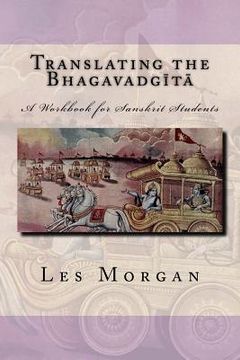Share
Translating the Bhagavadgita: A Workbook for Sanskrit Students (in English)
Les Morgan
(Author)
·
Createspace Independent Publishing Platform
· Paperback
Translating the Bhagavadgita: A Workbook for Sanskrit Students (in English) - Morgan, Les
$ 8.96
$ 11.20
You save: $ 2.24
Choose the list to add your product or create one New List
✓ Product added successfully to the Wishlist.
Go to My WishlistsIt will be shipped from our warehouse between
Wednesday, June 19 and
Thursday, June 20.
You will receive it anywhere in United States between 1 and 3 business days after shipment.
Synopsis "Translating the Bhagavadgita: A Workbook for Sanskrit Students (in English)"
In a series of easy modules you will get a brief and practical introduction to translation technique for beginning Sanskrit students. Using an immersion method, you will create your own translation of chapter 12 of the Bhagavadgita, which is just twenty verses long. I encourage you to jump right in to create your own translation even if you aren't sure your skills are up to it. Designed for students with limited knowledge of grammar, the workbook gives "just in time" tutorial tips for each verse, along with word-by-word vocabulary, alternate translations, and tips on translation technique. Something you will not find here is heavy grammatical analysis. The goal is to get you interested in some of the beautiful ideas that this great scripture presents. Comparing several versions will give you a deeper appreciation of the decisions that translators face. The Bhagavadgita is a very old text written in Sanskrit for an audience that lived in a different culture. Can you help English readers and hear it speaking to them in today's world?The technical challenges of translating Sanskrit are an interesting subject in themselves. At all times one must balance clarity with a respect for the structure of the underlying Sanskrit verse. Given that the most important goal is to get the idea across clearly, you still have a lot of stylistic leeway in finding your own unique voice. A great translation not only says something meaningful it says it in a meaningful way.Because Sanskrit grammar and syntax are very different from English, completely literal translations sound rather odd. Word order is more flexible in Sanskrit than in English, and sometimes you must transpose the original order of ideas in order to express an idea clearly. Sanskrit uses many passive constructions, so you may need to adjust sentences to an active voice to make the sense more dynamic.Your audience matters too. Being clear depends on who your reader is and how much they know about Indian thought. You may successfully convey what the source material says, but leave everyone confused because the subject matter is difficult to understand or in conflict with some other school of thought that they have previously been exposed to. If you assume too much, you may wind up with a translation into "Indologese", incomprehensible to anyone but specialists.
- 0% (0)
- 0% (0)
- 0% (0)
- 0% (0)
- 0% (0)
All books in our catalog are Original.
The book is written in English.
The binding of this edition is Paperback.
✓ Producto agregado correctamente al carro, Ir a Pagar.

